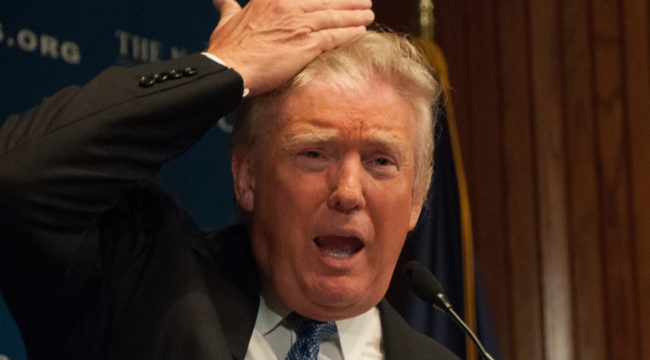Trump’s $2 Trillion Headache
Bad news first…
By 9:30 this morning the Dow was down more than 700 points off its March 1 high.
And since the Dow closed the day down again (-45 points), that’s eight straight days in the red — its longest losing streak since 2011.
Now the good news…
The Dow rallied some 113 points since 9:30. So it ended the day only down 45.
Meanwhile, the Nasdaq’s up a workmanlike 11 points. Health care stocks are up!
(To think, some readers accuse us of harping on the negative.)
But after Friday’s health care debacle… a $2 trillion question mark now hovers over Wall Street.
It’s a question mark Trump must tackle — and fast. At stake is the beating heart of his economic agenda.
Details to follow…
But first, what’s the scuttlebutt on Wall Street today?
“The market’s patience is wearing thin,” warns UniCredit’s head of global FX strategy Vasileios Gkionakis, adding: “It definitely doubts the U.S. administration’s ability to push forward [with] this so much talked and discussed agenda including the fiscal stimulus, tax deregulation, tax cuts.”
“Investors are viewing this setback as a broader loss of faith in the Trump administration’s ability to deliver on other campaign pledges — namely tax and spending policies, which have underpinned asset prices since the U.S. elections,” affirms Viraj Patel, ING currency analyst.
More or less what you’d expect.
But Zero Hedge’s pseudonymous Tyler Durden raises a far more urgent concern…
With Obamacare spending cemented in place, Durden says Trump’s now facing a “nightmare scenario” — a $2 trillion funding shortage that threatens tax reform.
Durden cites Larry Lindsey, former economic adviser to George W. Bush. Lindsey argues that the failed Ryan plan was crucial to tax reform because, unlike Obamacare, it would have generated revenue:
[It was] necessary for budgetary reasons, for tax reform, because it was a revenue gainer.
But now that the Ryan plan’s sunk, Obamacare’s spending increases are locked in place. That leaves less room for tax cuts — without exploding the deficit.
Essentially, the Ryan plan’s failure leaves much less room to lower taxes.
That is, much less room for the lower taxes that goosed the Trump “reflation trade.”
If Republicans want to forge ahead with tax cuts without ballooning the deficit, Durden figures they’ll have to slash $1 trillion in spending over the next decade. Or find the revenue somewhere else.
A nasty cleft to be in.
As Durden explains, “If Republicans want to eliminate the Obamacare taxes as part of tax reform and ensure the bill does not add to the deficit… they will have to raise almost $1 trillion in revenue.”
So that accounts for $1 trillion. But we mentioned a potential $2 trillion revenue shortfall.
What accounts for the other trillion?
Enter the border adjustment tax (BAT)…
Team Trump has proposed a controversial 20% border adjustment tax. They estimated it would generate up to $1.18 trillion in revenue over the next decade. That added revenue would help clear space for the other tax cuts.
As The Hill puts it:
“The BAT would levy a 20% tax on imported goods and would allegedly raise over a trillion dollars of revenue over the next decade, enough to pay for a significant corporate income tax cut.”
But Trump squandered loads of precious political capital on health care. Now seemingly whooped, he’ll have that much less capital left to pass BAT.
And the long knives are already out against it.
Americans would pay more for many imported items — oil, cars, clothing, food, electronic gadgets and more.
A UBS securities analysis suggests average U.S. consumer prices could surge 8% with a BAT.
We hazard not many Republican politicians will like telling their customers why they’re paying 8% more at Wal-Mart.
And speaking of Wal-Mart, the Wal-Marts of the world are known to wield some lobbying… influence.
A politically weakened Trump and lukewarm support for the measure, lots of opposition. Add it together and BAT’s one big question.
If BAT joins health care at the bottom, that’s another $1 trillion-plus of lost revenue — that is, $1 trillion less to finance the tax cuts.
Adding that $1 trillion-plus to the trillion Obamacare costs… and you’ve got the $2 trillion funding hole Durden referenced.
That’s potentially $2 trillion less for tax cuts.
A handsome number, even for Washington.
Has Wall Street done the math?
Some analysts originally estimated Trump’s plans could generate growth on the order of 2–4%.
But Jared Bernstein, senior fellow from the Center on Budget and Policy Priorities, says the calculus has changed.
Per CNBC, he says those figures “look more like 1–2% now because of budgetary constraints.”
Big difference.
So the market nears a moment of truth… a tipping point of sorts.
Is it time to “buy the dip” one more time? It’s paid most of the time for the past eight or so years.
Or is now finally the time to get out of Dodge City?
Regards,
Brian Maher
Managing editor, The Daily Reckoning



Comments: